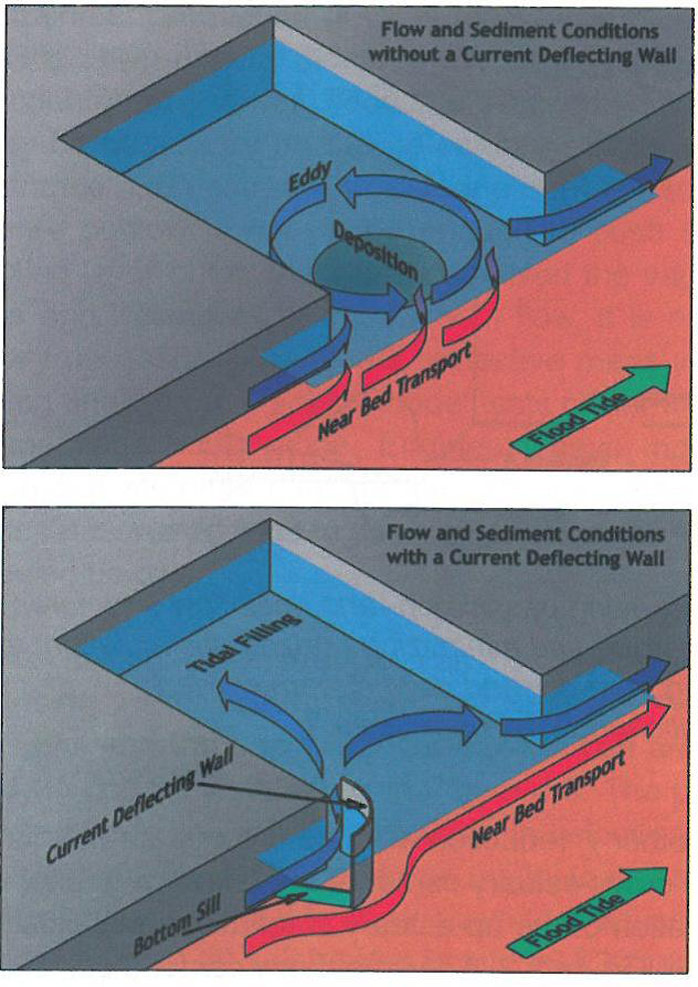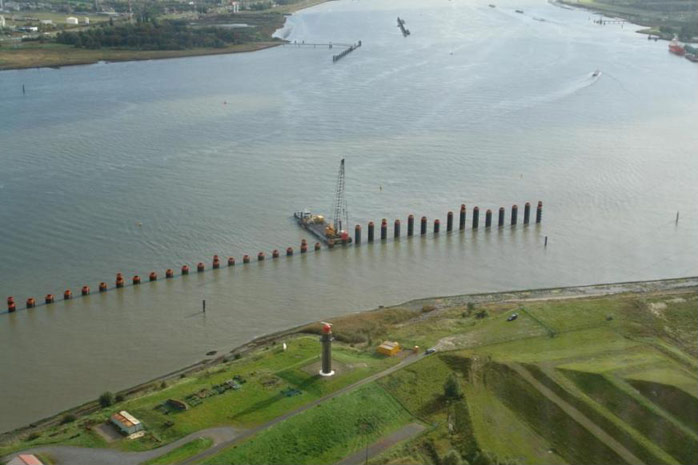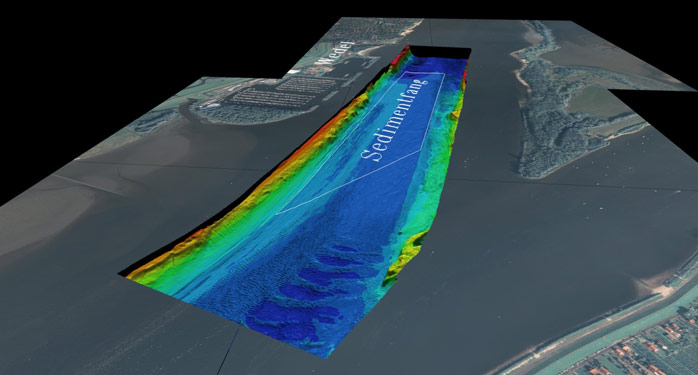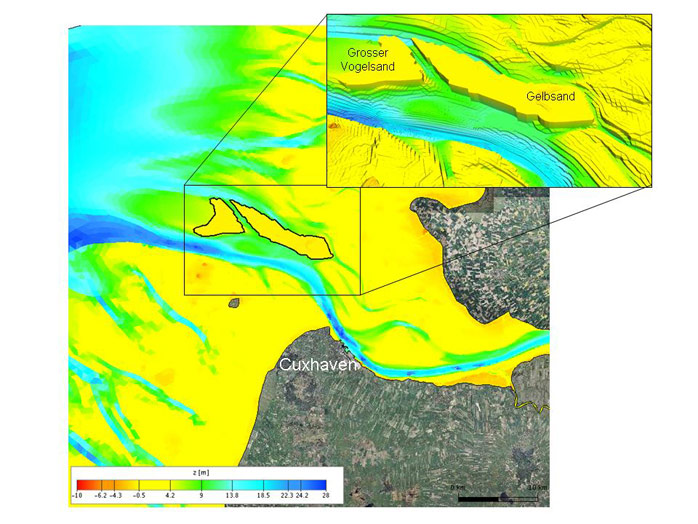

Disclaimer:
The authors are solely responsible for the content of this report. Material included herein does not represent the opinion of the European Community, and the European Community is not responsible for any use that might be made of it.
Back to overview reports
The occurrence of high sedimentation is also a topic in many realignment measures and in projects that cope with the revitalization of anabranches and former side channels (BIOCONSULT & NLWKN 2012). With the on-going sedimentation, necessary ecological functions cannot be provided anymore, e.g. valuable shallow water areas which provide food and spawning ground for fish species silt up and develop into mudflats.
Within the TIDE project, measures which are or will be conducted in the four estuaries are collected and evaluated. Some of these measures aim to reduce sedimentation and the dredging necessities respectively. This paragraph first gives an overview on potential measures being able to reduce or avoid sedimentation and subsequently describes what has been done at the four TIDE estuaries in this context so far.
As sedimentation processes are governed by a lot of different factors, there are various starting points in the development of measures to control sedimentation (PIANC 2008):
In estuaries, sediment transport is controlled by the tides and the resulting currents and by freshwater discharge. Therefore some measures focus on influencing or inhibiting the currents. In a port, the most obvious measure is to close a harbour basin via a dock or a jetty construction in order to reduce or prevent the occurrence of waves and currents within these areas. This measure keeps the water navigable and locks out undesired currents and sediments. Most of the harbour basins at the TIDE ports of Antwerp, Hull and Bremerhaven are located behind the locks. In contrast, the port of Hamburg is completely open to the tides and related currents.
The currents can be controlled by a current deflecting wall, for instance. The deflector structure modifies the flow patterns resulting in the diminishment of eddy flows which cause high sedimentation rates (Figure 17).
A current deflecting wall was successfully installed in the port of Hamburg (HPA 2012 C). The applicability of this method was tested for the Port of Antwerp as well. Although the boundary conditions in Antwerp differed from those in Hamburg (e.g. salinity gradient and density gradient), the modelling exercise showed that a current deflecting wall could reduce the sedimentation rates inside the new build Deurganckdok harbour basin (VAN MAAREN et al. 2010). The deflecting wall in Antwerp was implemented in 2011 (Figure 18); it is expected to lead to a 15 - 20 % reduction of sedimentation.
Additionally, the freshwater discharge coming from upstream could be affected in a beneficial way. At the Elbe estuary, there is less sedimentation in the harbour area during periods of high fresh water discharge in winter and spring due to the flushing effect of the freshwater. Therefore an investigation on the possibilities of avoiding sedimentation via freshwater discharge control, between the two Elbe branches was conducted (HPA 2012d) . This study was contracted out with regard to the specific situation at the Elbe estuary (high freshwater discharge and division in northern and southern Elbe branch), but regulating the freshwater current might be possible to be implemented at other estuaries as well.
The study on the revitalization of the anabranch ´Schweiburg´ at the Weser estuary (BIOCONSULT & NLWKN 2012 ) lists several options for the maintenance of the shallow water area. However, it became clear that by means of some limited technical measures the aim of self-preservation and – therefore – comprehensive revitalisation of the area could not be achieved. In order to revitalise some of the ecological functions of the anabranch and to improve the prediction of the desired effects, further research is needed.
Sediment trapping
Sedimentation can be avoided by trapping the sediments before they reach a critical area by widening or deepening some parts of the river channel. The current will decline and a part of the suspended sediment will settle within the sediment trap. If the transport regime mostly consists of bed load transport, the sediments will also sink at the abrupt depression and finally settle in the trap.
This measure does not reduce the dredging amounts, but it is an advantage that the necessary dredging can be planned and therefore will interfere to a lesser extent with the vessel traffic and the port operation. Additionally the sediments inside the trap will consolidate over a longer period of time leading to a more effective dredging due to higher sediment densities in the trap (DAVIS & MCANALLY 2010).
Sediment trapping is a well-known management option for rivers, but not for estuaries. The changing flow directions of the tides and the different ways of sediment transport make the effects of sediment trapping difficult to predict.
Therefore, HAYDEL & MCANALLY (2002) pointed out that the trap design should be adapted to the specific site characteristics (sediment and flow characteristics, river hydrography and facility size).
In 2008, HPA and WSV (Federal Administration of Waterways and Navigation) installed a sediment trap adjacent to the port of Hamburg (measure 5; HPA 2012e) Functioning and impacts on the environment were reported and evaluated within the TIDE project (HPA 2013).
Determining and using the navigable depth in fluid mud layers
In estuaries with a high amount of fine sediments, very often a thick, more or less mobile layer of fluid mud can be observed in the riverbed. For systems with high turbidity regimes and fluid mud layers, it is convenient to determine the thickness of the fluid mud layer which can be passed through by ships. If this certain thickness at a determined water depth (nautical depth) is not exceeded, dredging activities will not be necessary.
The prediction of the nautical depth through the fluid mud layers (density up to 1.25 t/m³), i.e. detecting the depth at which the fluid mud reaches this critical density, is not simple. It is difficult to obtain a useful profile of fluid mud density by acoustic methods. Any abrupt change in density, e.g. at the interface between 'dirty water' and freshly settled fluid mud, will give a signal, but progressive density changes cannot be registered. As a result, an echo sounder will often return at least two signals: a 'hard' echo from the denser, well-consolidated mud of the riverbed, and a 'soft' echo from the interface between the water and the top of the fluid mud.
Associated British Ports (ABP) is using a new technique to determine the navigable depth in their ports and the shipping channel of the Humber: they measure the density of 'fluid mud' with a device called Hydromotion MudBug (Figure 20; EA 2012c ). The technique, which is still new, allows the determination of the navigable depth more accurately. Therefore unnecessary dredging activities can be avoided.
Sediment conditioning
Further, unnecessary dredging can be avoided by sediment conditioning. That means that the method of water-injection is applied to keep the water navigable. Air is introduced in already consolidated mud in order to transform it to fluid mud (in-situ conditioning). This method is successfully used in the port of Emden as well as in Bremerhaven (Weser estuary) and Rotterdam (GREISER 2004, WURPTS 2005). However, this method cannot be applied in estuaries in which the sediment is dominated by sand. Besides, this suspended sediment loading in the water column will probably not be reduced by this method.
Investigations at the Scheldt estuary showed that dredged material can be used to positively affect estuarine currents (eg TIDE measures 20-23 (Walsoorden ) and measure 19 (Navigation channel near Ketelplaat ).
In relation to the planned deepening of the fairway of the Elbe several underwater relocation areas will be constructed with dredged material. They should dissipate the tidal energy, which should lead to a decrease of the tidal range and subsequently to a lower upstream sediment transport (see measure 02 “Medemrinne Ost ”).
Additionally the implementation of the measure Spadenlander Busch in the Elbe estuary (see measure 01 ) is meant to work against the increased sediment transport by dissipating tidal energy and therefore positively affecting the tidal conditions. Within the framework of TIDE possible mitigation measures in the estuary mouth of the rivers Elbe (Figure 21) and Scheldt were studied (see MOW & HPA 2013 ) that showed a possible basis for future research.
Back to top
How can public acceptance for management actions be increased?
How can the Ecosystem Services Approach be used to support management decisions?
How can we assure accessibility to an inland estuarine port without affecting the habitats and safety against flooding?
How can we prevent excessive degradation or loss of tidal marshes?
How does habitat management affect the supply of ecosystem services?
What are the key areas of conflicts or synergies in TIDE estuaries?
What are the restoration opportunities for side branch systems and river banks (e.g. left side branch Weser)?
What factors determine the distribution of suspended sediments in an estuary?
What measures are successful for the dissipation of tidal energy?
What monitoring is required to support and assess management decisions?
What parameters should be used to define and evaluate measure targets?
What tool is available to help manage multiple users of a resource in an integrated way (i.e. achieving more holistic management)?
Which aspects do I have to take into account in order to make a measure a success?
Which measures are suitable to achieve specific ecological targets?
Which measures are suitable to achieve specific morphological and hydrological targets?
Which measures are suitable to identify, protect or develop valuable submerged habitats e.g. mussel beds and Sabellaria reefs?
Which measures are suitable to improve the physical characteristics and chemical water quality?
Which measures are suitable to provide ecosystem services and benefits?
Which synergistic effects and conflicts can be expected by planning and implementing a certain measure?
“Working with nature”: What are the opportunities for sediment management in estuaries?
Management measures analysis and comparison
Table of content
- 1. Aim of the study
- 2. Work organisation
- 2a. Transnational Working Group Measures (TWG Measures)
- 2b. Regional Working Groups
- 3. Working steps and methods
- 3a. Measure collection and compilation of basic information
- 3b. Analysis approach development
- 3c. Consistency check of analysis results
- 3d. Develop concepts for cross estuary comparison of measures
- 3e. Deduce recommendations for estuary managers
- 4. Pilot projects
- 5. Results of measure collection and analysis
- 5a. Measure collection and basic info compilation
- 5b. Measure analysis
- 6. Specific issues of cross estuary comparison of measures
- 6a. Managed re-alignment measures (APA)
- 6b. Measures influencing sedimentation processes (HPA)
- 7. Summary and conclusions
- 7a. Procedure
- 7b. Results
- 8. Recommendations
- 9. References
- 10. Annex
- 10a. Composition of Regional Working Groups identifying main pressures and resulting deficits for the estuary zone using Environmenta
- 10b. Templates for evaluation of measures in terms of WFD aims: Identification of pressures and explanation of resulting deficits for
- 10c. Templates for evaluation of measures in terms of Natura 2000 aims: Conservation objectives for relevant operational areas based
- 10d. List of collected measure examples from Weser, Elbe, Humber and Scheldt with indication of development targets
- 10e. Assignment of collected measure examples from Weser, Elbe, Humber and Scheldt to measure categories
- 10f. Overview maps on measure titles and locations
- 10g. Assignment of collected measure examples from Weser, Elbe, Humber and Scheldt to measure types
6b. Measures influencing sedimentation processes (HPA)
Introduction
High amounts of suspended sediments are a common feature in estuaries. These suspended solids settle mainly in areas of low current velocities like harbour basins or anabranches. High sedimentation rates are an important issue for ports and waterways administrations, because the costs for maintenance dredging often sum up to millions of euros. Therefore port and waterways operators are interested in solutions leading to the reduction of the maintenance dredging needs, as well inside the port areas as in the fairway. Maintenance dredging is therefore a big issue in the four TIDE estuaries.The occurrence of high sedimentation is also a topic in many realignment measures and in projects that cope with the revitalization of anabranches and former side channels (BIOCONSULT & NLWKN 2012). With the on-going sedimentation, necessary ecological functions cannot be provided anymore, e.g. valuable shallow water areas which provide food and spawning ground for fish species silt up and develop into mudflats.
Within the TIDE project, measures which are or will be conducted in the four estuaries are collected and evaluated. Some of these measures aim to reduce sedimentation and the dredging necessities respectively. This paragraph first gives an overview on potential measures being able to reduce or avoid sedimentation and subsequently describes what has been done at the four TIDE estuaries in this context so far.
As sedimentation processes are governed by a lot of different factors, there are various starting points in the development of measures to control sedimentation (PIANC 2008):
- Keep the sediments out
- Keep the sediments suspended
- Keep the sediments navigable
- Influencing the sedimentation process directly by preventing the entry of sediments in a certain area, by altering the current dynamics or by trapping the sediments before they can enter a sedimentation hot spot
- Influencing the sedimentation process indirectly by altering general transport patterns within the estuary in a way that leads to lower sedimentation rates
Direct approaches of sedimentation control
Current controlIn estuaries, sediment transport is controlled by the tides and the resulting currents and by freshwater discharge. Therefore some measures focus on influencing or inhibiting the currents. In a port, the most obvious measure is to close a harbour basin via a dock or a jetty construction in order to reduce or prevent the occurrence of waves and currents within these areas. This measure keeps the water navigable and locks out undesired currents and sediments. Most of the harbour basins at the TIDE ports of Antwerp, Hull and Bremerhaven are located behind the locks. In contrast, the port of Hamburg is completely open to the tides and related currents.
The currents can be controlled by a current deflecting wall, for instance. The deflector structure modifies the flow patterns resulting in the diminishment of eddy flows which cause high sedimentation rates (Figure 17).
A current deflecting wall was successfully installed in the port of Hamburg (HPA 2012 C). The applicability of this method was tested for the Port of Antwerp as well. Although the boundary conditions in Antwerp differed from those in Hamburg (e.g. salinity gradient and density gradient), the modelling exercise showed that a current deflecting wall could reduce the sedimentation rates inside the new build Deurganckdok harbour basin (VAN MAAREN et al. 2010). The deflecting wall in Antwerp was implemented in 2011 (Figure 18); it is expected to lead to a 15 - 20 % reduction of sedimentation.
Additionally, the freshwater discharge coming from upstream could be affected in a beneficial way. At the Elbe estuary, there is less sedimentation in the harbour area during periods of high fresh water discharge in winter and spring due to the flushing effect of the freshwater. Therefore an investigation on the possibilities of avoiding sedimentation via freshwater discharge control, between the two Elbe branches was conducted (HPA 2012d) . This study was contracted out with regard to the specific situation at the Elbe estuary (high freshwater discharge and division in northern and southern Elbe branch), but regulating the freshwater current might be possible to be implemented at other estuaries as well.
The study on the revitalization of the anabranch ´Schweiburg´ at the Weser estuary (BIOCONSULT & NLWKN 2012 ) lists several options for the maintenance of the shallow water area. However, it became clear that by means of some limited technical measures the aim of self-preservation and – therefore – comprehensive revitalisation of the area could not be achieved. In order to revitalise some of the ecological functions of the anabranch and to improve the prediction of the desired effects, further research is needed.
Sediment trapping
Sedimentation can be avoided by trapping the sediments before they reach a critical area by widening or deepening some parts of the river channel. The current will decline and a part of the suspended sediment will settle within the sediment trap. If the transport regime mostly consists of bed load transport, the sediments will also sink at the abrupt depression and finally settle in the trap.
This measure does not reduce the dredging amounts, but it is an advantage that the necessary dredging can be planned and therefore will interfere to a lesser extent with the vessel traffic and the port operation. Additionally the sediments inside the trap will consolidate over a longer period of time leading to a more effective dredging due to higher sediment densities in the trap (DAVIS & MCANALLY 2010).
Sediment trapping is a well-known management option for rivers, but not for estuaries. The changing flow directions of the tides and the different ways of sediment transport make the effects of sediment trapping difficult to predict.
Therefore, HAYDEL & MCANALLY (2002) pointed out that the trap design should be adapted to the specific site characteristics (sediment and flow characteristics, river hydrography and facility size).
In 2008, HPA and WSV (Federal Administration of Waterways and Navigation) installed a sediment trap adjacent to the port of Hamburg (measure 5; HPA 2012e) Functioning and impacts on the environment were reported and evaluated within the TIDE project (HPA 2013).
Determining and using the navigable depth in fluid mud layers
In estuaries with a high amount of fine sediments, very often a thick, more or less mobile layer of fluid mud can be observed in the riverbed. For systems with high turbidity regimes and fluid mud layers, it is convenient to determine the thickness of the fluid mud layer which can be passed through by ships. If this certain thickness at a determined water depth (nautical depth) is not exceeded, dredging activities will not be necessary.
The prediction of the nautical depth through the fluid mud layers (density up to 1.25 t/m³), i.e. detecting the depth at which the fluid mud reaches this critical density, is not simple. It is difficult to obtain a useful profile of fluid mud density by acoustic methods. Any abrupt change in density, e.g. at the interface between 'dirty water' and freshly settled fluid mud, will give a signal, but progressive density changes cannot be registered. As a result, an echo sounder will often return at least two signals: a 'hard' echo from the denser, well-consolidated mud of the riverbed, and a 'soft' echo from the interface between the water and the top of the fluid mud.
Associated British Ports (ABP) is using a new technique to determine the navigable depth in their ports and the shipping channel of the Humber: they measure the density of 'fluid mud' with a device called Hydromotion MudBug (Figure 20; EA 2012c ). The technique, which is still new, allows the determination of the navigable depth more accurately. Therefore unnecessary dredging activities can be avoided.
Sediment conditioning
Further, unnecessary dredging can be avoided by sediment conditioning. That means that the method of water-injection is applied to keep the water navigable. Air is introduced in already consolidated mud in order to transform it to fluid mud (in-situ conditioning). This method is successfully used in the port of Emden as well as in Bremerhaven (Weser estuary) and Rotterdam (GREISER 2004, WURPTS 2005). However, this method cannot be applied in estuaries in which the sediment is dominated by sand. Besides, this suspended sediment loading in the water column will probably not be reduced by this method.
Indirect approaches of sedimentation control (mitigation)
Most of the estuaries of the North Sea Region have been altered to a great extend over the last century (HAMER 2013 ). The tidal range has typically increased in the upper estuary which leads often to an increase in upstream sediment transport and higher sedimentation rates in anabranches and port areas. The mitigation of these – negative – effects is also considered as an option.Investigations at the Scheldt estuary showed that dredged material can be used to positively affect estuarine currents (eg TIDE measures 20-23 (Walsoorden ) and measure 19 (Navigation channel near Ketelplaat ).
In relation to the planned deepening of the fairway of the Elbe several underwater relocation areas will be constructed with dredged material. They should dissipate the tidal energy, which should lead to a decrease of the tidal range and subsequently to a lower upstream sediment transport (see measure 02 “Medemrinne Ost ”).
Additionally the implementation of the measure Spadenlander Busch in the Elbe estuary (see measure 01 ) is meant to work against the increased sediment transport by dissipating tidal energy and therefore positively affecting the tidal conditions. Within the framework of TIDE possible mitigation measures in the estuary mouth of the rivers Elbe (Figure 21) and Scheldt were studied (see MOW & HPA 2013 ) that showed a possible basis for future research.
6b. Recommendations
There are several ways of positively influencing the negative consequences of changes in the tidal regime and related sedimentation processes in estuaries. For choosing the most successful measure it is necessary to carefully study the specific relations between currents, tidal range and sediment transport before it is possible to alter the system in a beneficial way.Important to know
Reports / Measures / Tools
| Report: | Management measures analysis and comparison |
|---|
Management issues
How and by which management measures can tidal amplification be reduced?How can public acceptance for management actions be increased?
How can the Ecosystem Services Approach be used to support management decisions?
How can we assure accessibility to an inland estuarine port without affecting the habitats and safety against flooding?
How can we prevent excessive degradation or loss of tidal marshes?
How does habitat management affect the supply of ecosystem services?
What are the key areas of conflicts or synergies in TIDE estuaries?
What are the restoration opportunities for side branch systems and river banks (e.g. left side branch Weser)?
What factors determine the distribution of suspended sediments in an estuary?
What measures are successful for the dissipation of tidal energy?
What monitoring is required to support and assess management decisions?
What parameters should be used to define and evaluate measure targets?
What tool is available to help manage multiple users of a resource in an integrated way (i.e. achieving more holistic management)?
Which aspects do I have to take into account in order to make a measure a success?
Which measures are suitable to achieve specific ecological targets?
Which measures are suitable to achieve specific morphological and hydrological targets?
Which measures are suitable to identify, protect or develop valuable submerged habitats e.g. mussel beds and Sabellaria reefs?
Which measures are suitable to improve the physical characteristics and chemical water quality?
Which measures are suitable to provide ecosystem services and benefits?
Which synergistic effects and conflicts can be expected by planning and implementing a certain measure?
“Working with nature”: What are the opportunities for sediment management in estuaries?




